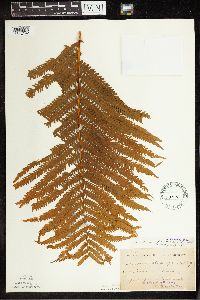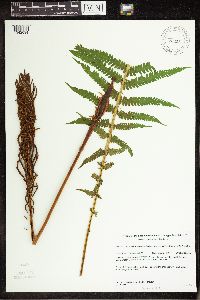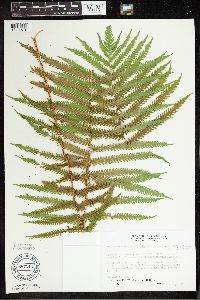Matteuccia struthiopteris var. pensylvanica
|
|
|
|
Family: Onocleaceae
ostrich fern
|
Leaves in vaselike cluster to 1.75 m. Sterile leaves oblanceolate, 30--130 × 12--25 cm. Petiole of sterile leaf black, 4.5--46 cm, flattened at base, becoming deeply grooved distally, scales pale orange-brown; rachis grooved; petiole and rachis occasionally puberulent. Pinnae linear, 20--60 per side, longest 6.5--13.5 cm, gradually decreasing in length toward base; segments 20--40 pairs per pinna. Petiole of sporophyll 11--24 cm, base scaly. Blade oblong to oblanceolate, 15--40 × 2.5--6.5 cm. Pinnae greenish, becoming dark brown at maturity, linear, 30--45 per side, 3--5.6 cm, constricted at regular intervals. 2 n = 80. Sporophylls produced in mid to late summer, persisting through winter. Rich woods, often in alluvial or mucky swamp soils; 0--1500 m; Alta., B.C., Man., N.B., Nfld., N.W.T., N.S., Ont., P.E.I., Que., Sask., Yukon; Alaska, Conn., Del., Ill., Ind., Iowa, Maine, Md., Mass., Mich., Minn., Mo., N.H., N.J., N.Y., N.Dak., Ohio, Pa., R.I., S.Dak., Vt., Va., W.Va., Wis. The name Pteretis nodulosa (Michaux) Nieuwland has been misapplied to this species. Matteuccia struthiopteris is most common in northeastern North America, primarily north of the limit of Wisconsin glaciation. The sporangia dehisce in the spring before the new sterile leaves have expanded, thus releasing the spores into an unimpeded airstream (R. W. Hill and W. H. Wagner Jr. 1974). The green spores germinate in two to five days (R. M. Lloyd and E. J. Klekowski Jr. 1970). Matteuccia struthiopteris var. struthiopteris , which differs in its bicolored petiole scales and more truncate pinna lobes, occurs in temperate Eurasia. As in Onoclea sensibilis , leaf forms intermediate between sterile leaves and sporophylls are sometimes found (M. L. Fernald 1935). Matteuccia struthiopteris has been used as a landscaping plant in the United States and Canada, where it is frequently planted as a border along house foundations. It is also the source of edible fiddleheads, the canning of which is a local industry in New England and adjacent Canada. The fiddlehead of M . struthiopteris is the state vegetable of Vermont.
Perennial fern 30 cm - 1.8 m tall Leaves: several, in vase-like cluster, long-stalked, pinnately compound into linear divisions (pinnae) with unbranched veins, and grooved "midrib" (rachis). Two kinds of leaves are produced: sterile leaves, which die back in winter; and fertile leaves, which are produced in mid- or late summer, and persist over winter. Rhizome: black, stout, scaly, long-creeping, deep, yet ascending at an angle or erect near and above ground level. Leaf stalks: clustered, ascending, long (4.5 - 46 cm long on sterile leaves, 11 - 24 cm long on fertile leaves) with orange-brown scales near the flattened, blackish, swollen bases. The swollen bases of the leaf stalks persist over winter and store starch grains, these structures are called trophopods. Spores: 64 per sac, greenish, all of one kind, single-sectioned (monolete), oblong or kidney-shaped, with folds and minute projections. The spores give rise to the gametophyte (the sexual phase of the plant), which is small, green, heart-shaped, hairless or often with glands or hairs, and sits above the ground. Sterile leaves: green, herbaceous, large, 30 cm - 1.3 m long, 12 - 25 cm wide, widest above middle, inversely lance-shaped in outline, but pinnately divided, with stalk and central "midrib" (rachis) occasionally hairy. Fertile leaves: greenish but becoming dark brown, hardened, long and narrow (15 - 40 cm long, 2.5 - 6.5 cm wide), oblong to inversely lance-shaped in outline, but pinnately divided into 30 - 45 pairs of very slender, linear, 3 - 5.6 cm long segments (pinnae) with hard, under-rolled edges. Similar species: Matteuccia struthiopteris var. pensylvanica probably most closely resembles Deparia acrostichoides, but the fertile and sterile leaves of that species are the same shape and both die back in winter, further its leaf divisions (pinnae) always have multicellular hairs along the top and bottom of the "midvein" (costae), and the sori are elongate and covered by a somewhat thick flap of tissue (indusium). Some may confuse Osmunda cinnamomea with this species because the fertile leaves are obviously different from the sterile ones, and their sterile leaves are somewhat similarly shaped and colored (brownish), but in O. cinnamomea, the sporangia on the fertile leaves are exposed rather than covered by the rolled edges of the pinnae. Smaller sterile leaves of M. struthiopteris var. pensylvanica may be confused with those of Woodwardia virginica, but in that species the fertile leaves are much the same as the sterile ones, the sori are elongate, the veins along the pinnae costae and next to the midvein of the pinnae segments join together in netlike patterns to form discreet enclosures (areolae), and the sori are positioned close to the pinnae costae and segment midveins on top of the areolae. Superficially, some may confuse smaller sterile leaves with those of Thelypteris noveboracensis or T. palustris var. pubescens, but both those species will have obvious single-celled, transparent, needle-like hairs at least along the leaf veins. Habitat and ecology: Not common, localized to moist, often calcareous woodlands on slopes or floodplains, especially in our more northern counties. Occurence in the Chicago region: native Notes: There are only three species in the genus Matteuccia, and only one of those exists in North America. All the North American plants of M. struthiopteris are in the variety pensylvanica, while the typical variety occurs in Eurasia. This species has been named under several other genera including Onoclea, Pteretis, and Struthiopteris. However, the common name of the plant, Ostrich fern (referring to the fertile leaves that have a similar shape to an ostrich feather), has remained very consistent over the years. The genus Matteuccia, like the genus Onoclea, is known to store starch grains in the persistent leaf stalk bases (trophopods). This character has been used by some to place the two genera into a separate family, the Onocleaceae. Etymology: Matteuccia is named after Carlo Matteucci, 1800 - 1863, a physicist at the University of Florence, Italy. Struthiopteris is derived from the genus name for the ostrich, Struthiones, referring to the similarity in shape of the fertile leaves and an ostrich feather. Pensylvanica is a variant of pennsylvanica, meaning of or from Pennsylvania or more widely the eastern United States. Author: The Field Museum |

































































































